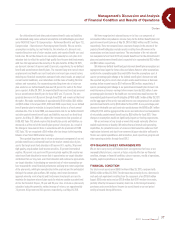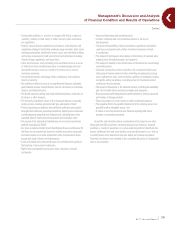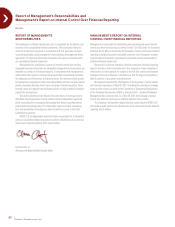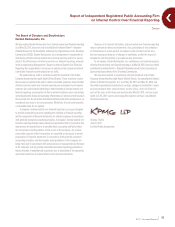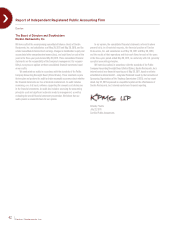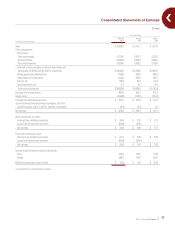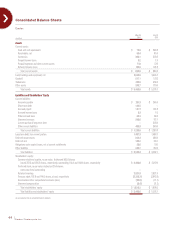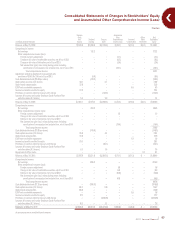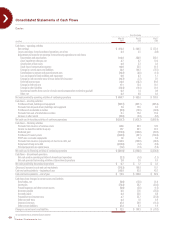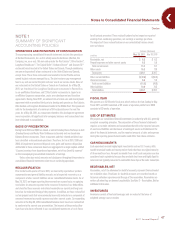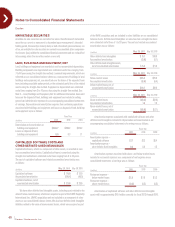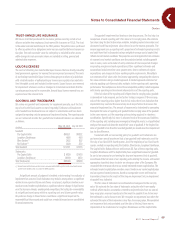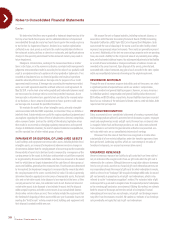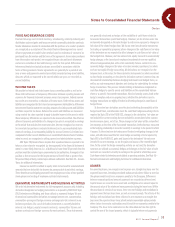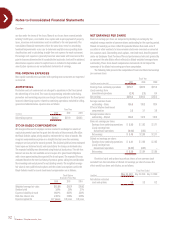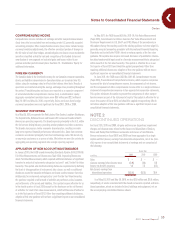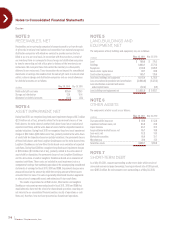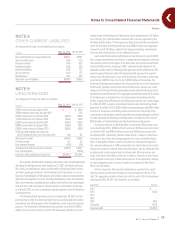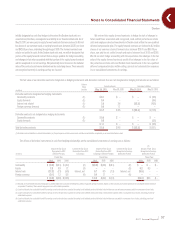Red Lobster 2011 Annual Report Download - page 49
Download and view the complete annual report
Please find page 49 of the 2011 Red Lobster annual report below. You can navigate through the pages in the report by either clicking on the pages listed below, or by using the keyword search tool below to find specific information within the annual report.
Notes to Consolidated Financial Statements
Darden
›
2011 Annual Report 47
NOTE 1
SUMMARY OF SIGNIFICANT
ACCOUNTING POLICIES
OPERATIONS AND PRINCIPLES OF CONSOLIDATION
The accompanying consolidated financial statements include the operations
of Darden Restaurants, Inc. and its wholly owned subsidiaries (Darden, the
Company, we, us or our). We own and operate the Red Lobster®, Olive Garden®,
LongHorn Steakhouse®, The Capital Grille®, Bahama Breeze® and Seasons 52®
restaurant brands located in the United States and Canada. Through subsidiaries,
we own and operate all of our restaurants in the United States and Canada,
except three. Those three restaurants are located in Central Florida and are
owned by joint ventures managed by us. The joint ventures pay management
fees to us, and we control the joint ventures’ use of our service marks. None of
our restaurants in the United States or Canada are franchised. As of May 29,
2011, we franchised five LongHorn Steakhouse restaurants in Puerto Rico
to an unaffiliated franchisee, and 22 Red Lobster restaurants in Japan to an
unaffiliated Japanese corporation, under area development and franchise
agreements. During fiscal 2011, we entered into a formal area and development
agreement with an unrelated third party to develop and operate our Red Lobster,
Olive Garden and LongHorn Steakhouse brands in the Middle East. The agreement
calls for the development of a minimum of 60 restaurants over the next five
years. As of May 29, 2011, no restaurants related to this development agreement
were in operation. All significant inter-company balances and transactions have
been eliminated in consolidation.
BASIS OF PRESENTATION
During fiscal 2007 and 2008 we closed or sold all Smokey Bones Barbeque & Grill
(Smokey Bones) and Rocky River Grillhouse restaurants and we closed nine
Bahama Breeze restaurants. These restaurants and their related activities have
been classified as discontinued operations. Therefore, for fiscal 2011, 2010 and
2009, all impairment losses and disposal costs, gains and losses on disposition
attributable to these restaurants have been aggregated in a single caption entitled
“(Losses) earnings from discontinued operations, net of tax (benefit) expense”
on the accompanying consolidated statements of earnings.
Unless otherwise noted, amounts and disclosures throughout these notes to
consolidated financial statements relate to our continuing operations.
RECLASSIFICATION
Prior to the fourth quarter of fiscal 2011, we incorrectly reported our workers
compensation and general liability accruals, net of expected recoveries, as a
component of other current liabilities on our consolidated balance sheets. As of
May 29, 2011, we began reporting these accruals on a gross basis, recognizing
receivables for amounts expected to be recovered in excess of our deductibles,
and classified these accruals and related receivables as current and long term
based on the estimated timing of the payments. In addition, we have reclassified
certain prepaid costs that were previously incorrectly included as a component of
unearned revenues to prepaid expenses and other current assets. Corresponding
amounts in the May 30, 2010 consolidated balance sheet have been reclassified
to conform to the current year presentation. The impacts of these reclassifica-
tions have also been reflected in our consolidated statements of cash flows
for all periods presented. These reclassifications had no impact on reported
earnings from continuing operations, net earnings or earnings per share.
The impacts of these reclassifications on our consolidated balance sheets
were as follows:
Increase (Decrease)
(in millions)
May 29, 2011 May 30, 2010
Receivables, net $ 6.6 $ 6.2
Prepaid expenses and other current assets 6.6 5.5
Total current assets 13.2 11.7
Other assets 16.5 17.0
Total assets $ 29.7 $ 28.7
Other current liabilities $(47.8) $(50.3)
Unearned revenues 6.6 5.5
Total current liabilities (41.2) (44.8)
Other liabilities 70.9 73.5
Total liabilities $ 29.7 $ 28.7
FISCAL YEAR
We operate on a 52/53 week fiscal year, which ends on the last Sunday in May.
Fiscal 2011 and 2010 consisted of 52 weeks of operation, while fiscal 2009
consisted of 53 weeks of operation.
USE OF ESTIMATES
We prepare our consolidated financial statements in conformity with U.S. generally
accepted accounting principles. The preparation of these financial statements
requires us to make estimates and assumptions that affect the reported amounts
of assets and liabilities and disclosure of contingent assets and liabilities at the
date of the financial statements, and the reported amounts of sales and expenses
during the reporting period. Actual results could differ from those estimates.
CASH EQUIVALENTS
Cash equivalents include highly liquid investments such as U.S. treasury bills,
taxable municipal bonds and money market funds that have an original maturity
of three months or less. Amounts receivable from credit card companies are also
considered cash equivalents because they are both short term and highly liquid in
nature and are typically converted to cash within three days of the sales transaction.
RECEIVABLES, NET
Receivables, net of the allowance for doubtful accounts, represent their estimated
net realizable value. Provisions for doubtful accounts are recorded based on
historical collection experience and the age of the receivables. Receivables are
writtenoffwhentheyaredeemeduncollectible.SeeNote3—Receivables,Netfor
additional information.
INVENTORIES
Inventories consist of food and beverages and are valued at the lower of
weighted-average cost or market.
›


